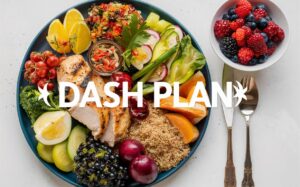High blood pressure, also known as hypertension, is a major risk factor for heart disease, stroke, kidney problems, and other serious health issues. Millions of people worldwide struggle with this “silent killer.” While medication is often necessary, one powerful tool rests right on your plate: the DASH diet.
DASH stands for Dietary Approaches to Stop Hypertension. It’s an eating plan designed with scientific rigor to combat high blood pressure and promote overall health. But DASH isn’t just a temporary fix; it’s a sustainable, delicious way of eating that can offer lifelong benefits.

What is the DASH Diet?
Here are the key features of this heart-healthy eating plan:
- Emphasis on Whole Foods: DASH encourages a diet rich in fruits, vegetables, whole grains, legumes, nuts, seeds, and low-fat dairy.
- Limit Processed Foods: Processed foods, often high in sodium, unhealthy fats, and added sugar, are best minimized on the DASH diet.
- Moderation of Red Meat and Sweets: Red meat and sugary treats are allowed in small amounts, as occasional indulgences.
- Sodium Control: The original DASH diet limits sodium significantly (2,300mg per day), but there’s even a lower sodium version (1,500mg per day) for increased blood pressure benefits.
- Nutrient Rich: DASH provides a wealth of important minerals like potassium, calcium, and magnesium – all proven to be beneficial for blood pressure control.
How Does DASH Lower Blood Pressure?
The DASH diet works in several ways to promote healthy blood pressure levels:
- Sodium Reduction: educing sodium consumption eases strain on blood vessels and allows your kidneys to flush away excess fluids more effectively.
- Potassium Power: Foods rich in potassium help combat sodium consumption while relaxing blood vessel walls.
- Magnesium Boost: This mineral is crucial for blood vessel relaxation.
- Calcium Benefit: Studies link sufficient calcium intake to healthy blood pressure.
- Fiber Focus: Fiber aids weight control and cholesterol management, both crucial for heart health.
The Benefits of DASH: Beyond Blood Pressure
DASH offers advantages that extend far beyond lowering blood pressure:
- Reduces Heart Disease Risk: DASH aligns with the dietary pattern known to reduce cardiovascular disease risk.
- Weight Management: By emphasizing whole foods, DASH naturally supports healthy weight management or loss.
- May Lower Cholesterol: DASH’s focus on fiber-rich foods and limited saturated fat can help improve cholesterol levels.
- Improved Insulin Sensitivity: DASH can be beneficial in managing or preventing type 2 diabetes.
Getting Started with the DASH Diet
Ready to try DASH? Here’s how to begin:
- Stock Up on Fruits and Vegetables: Aim to fill half of your plate with produce at each meal.
- Go Whole Grain: Swap refined grains for whole-wheat bread, brown rice, and whole-grain pasta.
- Include Dairy Wisely: Opt for low-fat or fat-free yogurt, milk, and cheese.
- Lean Protein Sources: Focus on fish, poultry, beans, lentils, nuts, and seeds.
- Limit Unhealthy Fats: Choose lean cuts of meat, and use healthy oils like olive oil sparingly.
- Read Food Labels: Check labels carefully, paying attention to sodium content.
- Talk to Your Doctor: Always consult your healthcare provider before starting any new diet, especially if you have underlying health conditions.
DASH Diet Tips and Tricks
- Gradual Changes: Start by gradually incorporating more DASH-friendly foods.
- Flavor Boost: Use herbs, spices, and citrus to add flavor without excess salt.
- Batch Cook: Prepare large batches of grains, beans, or roasted vegetables for easy meals throughout the week.
- Find Support: Online resources, cookbooks, or support groups can be motivational.
Sample DASH Meal Plan
- Breakfast: Oatmeal with berries and nuts, low-fat yogurt
- Lunch: Big salad with grilled chicken breast, whole-wheat roll
- Dinner: Baked salmon with roasted vegetables, quinoa
- Snacks: Fruit, handful of almonds, plain yogurt
Remember, consistency is key! Focus on making sustainable, enjoyable changes that become part of your healthy lifestyle.
Related Post:
Foods that naturally lower blood pressure
